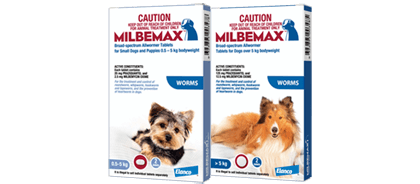The bite of the paralysis tick can be fatal, but there is another lesser-known danger associated with tick bites - the dangerous diseases ticks can transmit to your dog. Three tick-borne diseases of dogs in Australia are ehrlichiosis, babesiosis and anaplasmosis.
The risk of ticks to dogs
The clinical signs, or symptoms, of tick-borne diseases in dogs can vary from mild to severe, and can even be fatal, depending on the specific disease.
Ehrlichiosis
Brown dog ticks can rapidly transmit a bacterium (known as Ehrlichia canis) into a dog's bloodstream whilst feeding, leading to a serious disease called "ehrlichiosis". Ehrlichiosis is a new disease in Australia, with the first case diagnosed in a dog in Western Australia in 2020. Since then the disease has rapidly spread throughout northern WA, NT, QLD and northern SA, infecting thousands of dogs. Symptoms typically begin 2 to 4 weeks after a tick bite, and may include weakness, lethargy, fever, loss of appetite, weight loss, bleeding from the nose or under the skin resulting in anaemia and pale gums, and cloudy eyes or blindness. Without early antibiotic treatment, dogs may die or go on to experience recurring bouts of illness over months or years, which may ultimately be fatal.
Babesiosis
Brown dog ticks can also transmit babesiosis, a disease that can make dogs very ill, especially young pups, or dogs that are coinfected with other parasites such as hookworm. babesiosis is caused by a microscopic parasite (Babesia vogeli) that invades and destroys the dog's red blood cells, causing severe anaemia.
Symptoms of babesiosis can include: weakness; lethargy; loss of appetite; pale or yellow gums and skin, red, brown or yellow-orange urine; vomiting and diarrhoea.
Babesiosis is more prevalent in the subtropical and tropical northern regions of Australia but has also been diagnosed in dogs from southeastern Australia. Dingoes can also be infected and act as a reservoir of the disease for pet dogs.
Anaplasmosis
Brown dog ticks can also transmit a bacterium (called Anaplasma platys) responsible for causing the disease anaplasmosis or "canine infections cyclic thrombocytopenia". Bacteria transmitted through the bite of a tick enter the bloodstream to invade platelets, cells important for blood clotting. Infected dogs may show no signs of ill health or may develop bleeding disorders.
The brown dog ticks that spread these diseases are found predominantly across northern and central Australia (see Figure 1).

Figure 1. The approximate distribution (in red) of the brown dog tick (adapted from: Teo et al., Int J Parasitol. 2024 Jul;54(8-9):453-462).
Preventing tick-borne diseases in your pet
Tick-borne diseases can be difficult to treat, and despite treatment, some dogs will still die. Early diagnosis and treatment give dogs infected with tick-borne diseases the best chance for a successful outcome. If you are concerned about your dog’s health or suspect they may have a tick-borne disease, consult your vet. The best way to help protect dogs from these diseases is to protect them from being bitten by ticks in the first place.
Studies have shown that Ehrlichia canis can be transmitted within 3 hours of tick attachment1 , which is faster than most tick products can kill ticks. To protect dogs from ehrlichiosis, effective tick protection alone is not enough, it is critical to use a product that repels ticks to stop ticks from biting and spreading the disease. The Seresto™ collar is the only product that protects dogs against the deadly tick-borne disease, ehrlichiosis, because it works on the outside of the dog to repel ticks and kill them on contact so they don’t need to bite.
Always read the label and follow directions for use.

Advocate for dogs
Advocate provides fast relief from fleas, prevents deadly heartworm and helps protect your dog and your family from most intestinal worms

Milbemax™ worming tablets for dogs
Milbemax™ tablets for dogs protect against all the most common worms your dog will come into contact with, including tapeworm.




